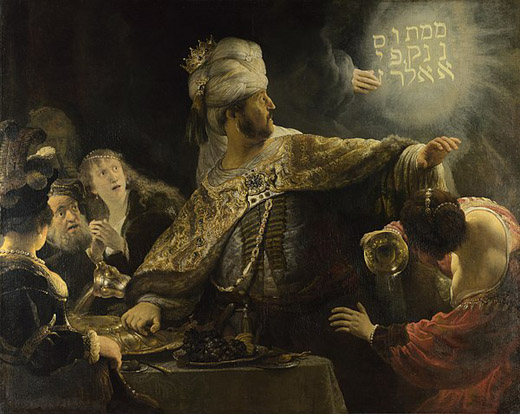
By Sam Ben-Meir
 EDINBURGH, Scotland – The Scottish National Gallery in Edinburgh is currently exhibiting a substantial selection of Rembrandt’s paintings, drawings, and prints – focusing on those works that reveal the story of “Britain’s Discovery of the Master.” Exploring the significance of Rembrandt to British collectors, artists, and writers provides us with the occasion to revisit some fifteen major oil paintings, beginning with an early Self-Portrait (1629), and including his only two portraits of British sitters, from 1634.
EDINBURGH, Scotland – The Scottish National Gallery in Edinburgh is currently exhibiting a substantial selection of Rembrandt’s paintings, drawings, and prints – focusing on those works that reveal the story of “Britain’s Discovery of the Master.” Exploring the significance of Rembrandt to British collectors, artists, and writers provides us with the occasion to revisit some fifteen major oil paintings, beginning with an early Self-Portrait (1629), and including his only two portraits of British sitters, from 1634.
Belshazzar’s Feast (1636-38) was among a handful of the first major paintings by Rembrandt to appear in Britain. It is also one of the most fascinating works to be included in this show, and is itself a kind of feast for the eye and mind. The painting draws its subject from the famous story in the Book of Daniel, in which the Jewish Temple is looted by the Babylonians; its holy artifacts, including “gold and silver vessels” are stolen by the king Nebuchadnezzar while his son Belshazzar makes a great feast where these sacred cups are profaned, until suddenly a disembodied hand appears and writes on the wall of the king’s palace the words “mene, mene, tekel, upharsin.” This is the moment that Rembrandt chose to capture, the moment of existential dread, as Belshazzar witnesses the writing which appears to be composed of light itself.
The sacred vessels are a recurring motif in this painting: in his palpable terror, Belshazzar has tipped over a golden chalice, which is speedily disgorging its contents onto the lavish table. Meanwhile, in the lower right corner, a woman crouches with her back to us – and although we cannot see her face, we know it is transfixed on the divine letters above. In her right hand she holds a vessel, which is also pouring itself out on to her red sleeve, drenching the garment along her forearm.
Another remarkable detail of this painting consists of Rembrandt’s unusual arrangement of the Hebrew letters – namely, in right-to-left columns rather than right-to-left rows which is how Hebrew is typically written. This could have been his way of accounting for the inability of the Babylonian wise men to make sense of the inscription, which ultimately leads to their sending for Daniel to help them understand it. As she plays the recorder, one faint mysterious figure in the extreme rear is looking directly at us – and she alone, an almost otherworldly apparition, appears to be without any fear. The painting is a breathtaking tour de force, and reveals an artist who thought deeply and penetratingly about the text that he rendered on canvas.
Four small drawings (which have been attributed to Rembrandt with some controversy) are exhibited here together for the first time. They date from around 1640, and are done in pen and brown ink, brown wash, and black chalk. The drawings depict various English views: St Albans Cathedral and Windsor Castle, while the remaining two offer views of London with Old St Paul’s in the background. The Dutch master certainly had in an interest in English subjects and ‘exotic’ architecture, which often made its way into his biblically-inspired paintings.
When Rembrandt was thirty-nine years old he painted Girl at a Window (1645), which is a wonderful example of the artist’s sense of mystery – taking a very simple subject and making it profoundly engaging. We are presented with a young woman in a loose-fitting white blouse and red cap, leaning forward on a stone ledge. She has a rounded face with a rosy complexion. While all that seems straightforward enough, there is great deal we might wonder about her: For one, who is she? For another, where is she? The space she inhabits is dark and tells us little. And when is she, for that matter? Her clothing could possible be that of a servant girl; though she could also be the artist’s lover, as some historians have speculated. She may even be a biblical figure, drawn from the Old Testament – strongly suggested by the timeless quality of her garb. What is perhaps most interesting about her is the direct gaze she levels at us, the viewer – the way she draws us into the picture, even gesturing toward herself with her left hand. The seductive quality of her is born out of that penetrating look, those large, searching eyes with which she seems to see us across the centuries – or rather, outside of time altogether.
The Mill (1645) was among the most cherished of Rembrandt’s painting during the nineteenth century, and understandably so. British romantics, such as Constable and Turner, were enamored with the somber, soulful atmosphere; the striking silhouette of the lone windmill against a stormy and foreboding sky is rendered with a dramatic chiaroscuro that would profoundly influence their work. With the restoration of the painting in 1977-79, the old discolored varnish was removed, and a very different, and brighter painting emerged – one that would have been rather unfamiliar to the nineteenth century romantics and connoisseurs who, like Wilhelm Bode, would proclaim it, “the greatest picture in the world.”
Like so much that Rembrandt does, this painting is deeply mysterious – when we consider, for example, the passing boatman in the lower right corner. Perhaps he is Charon, ferrying the departed across the river Styx – a reading which would have been more consistent perhaps with the earlier Romantic reception of the work. Rembrandt takes the ordinary, elemental things of life – water, air, and earth – and finds the truth within them, the truth of our human condition, the ephemeral beauty of the seemingly mundane, and the transiency of all things under the sun.
Head of an Old Man (1659) is truly a hauntingly unforgettable work: with bold and apparently rapid brushwork, Rembrandt captures with perfect sincerity, with unassailable honestly, the fragility but also the dignity, the complete humanity of old age. The white, tousled mane and discolored beard; the wrinkled brow with its deep-set lines; the large, darkening but questioning eyes that seem to peer into the beyond with all the wonder of being alive and facing the reality of our mortality – it is all there on the canvas. Rembrandt has caught it all and then some. The painting is staggeringly heartbreaking, and reveals the absolute timelessness of the artist – a work of art such as this is forever contemporary, because it is true – every stroke of the brush is true.
The exhibition concludes with a number of works by contemporary artists – including Frank Auerbach, Leon Kossoff, John Bellany, and Glenn Brown – who have taken inspiration, in one form or another, from the Dutch master. Some of these works fare better than others, when hanging next to Rembrandt. Among the most notable of these is Auerbach’s Study after Deposition by Rembrandt II (1961), a heavily impastoed work, which draws deeply on Rembrandt’s love of the chaotic. This is a rare and wonderful exhibition, which serves to remind us of the power of oil painting to reveal the wondrous enigma of being.
*
Sam Ben-Meir is a professor of philosophy and world religions at Mercy College in New York City.
What is the meaning of the Hebrew words?
Numbered, Numbered, Weighed, Divided — foretelling judgment